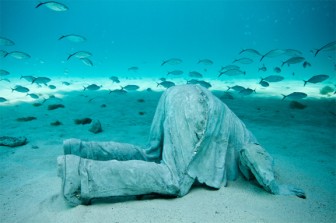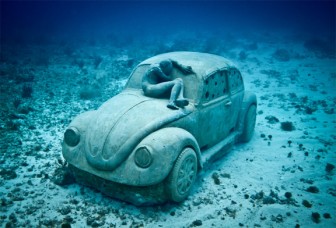By Anastasia Deonarinesingh

Anastasia Deonarinesingh is a Trinidadian student, graduating from the University of Toronto this year with a Bachelor of Science in Physics, Caribbean Studies and Mathematics. Her research interests focus on climate change and she hopes to pursue graduate studies in Civil Engineering and Environmental Sustainability.
Humans are the only species single handedly causing their own extinction. We strive for ways to become more “developed” without realizing that there is a price to development and economic stability. The price has been that our environment is suffering and some of us refuse to admit that it is affecting our daily lives while others of us are totally unaware of the issues at hand.
Global development has been facilitated by the use of fossil fuels and has resulted in what is called Climate Change. Climate Change, simply put, is just what it says, a change in climate, including temperature, humidity, atmospheric pressures, precipitation and wind patterns. This change may not seem obvious to some, but it explains the reasons for extreme weather patterns being experienced across the globe: colder winters in the northern hemisphere, hotter summers and dramatic changes in the hurricane seasons in the Caribbean.

The Caribbean region is one that is strongly dependent on the surrounding waters and the ecosystems in them. The oceans surrounding these tourist attractions house magnificent coral reefs like the Barrier Reef in Belize, which is the second largest in the world. Almost all the islands of the region have their own reef that has played a major part in their tourism economy and an even bigger role in the survival of their people as a food source and an income generator. As a result of stronger hurricane seasons and increased seas temperatures, beaches, coastlines and especially our coral reefs are being affected. Increased hurricane activity has been noticed in the region and a direct correlation to the decrease in coral reef cover throughout the region has been seen. After a disastrous hurricane season in 2005, up to 50% of reefs in the U.S. Virgin Islands, Puerto Rico, the Cayman Islands and other countries of the Greater Antilles were destroyed. This was in addition to about 73% of reefs in the Lesser Antilles being damaged by hurricane activity, including in Trinidad and Tobago. Beaches along the coast of Dominica and Barbuda, to name a few, were eroded by 2.5-17.5 m after one hurricane season. The effects of climate change do not end there and it is essential that changes be made, by us, to try to “fix” the damage that has been caused so far but also to prevent further effects.
One artist, Jason de Caires Taylor, is raising awareness of the social and environmental impacts of Climate Change through his work. De Caires Taylor was born to an English father and Guyanese mother and grew up in Europe and Asia. During his childhood he spent time exploring the reefs in Malaysia. His fascination with underwater ecosystems would become a full-time preoccupation when he graduated with a BA Hons in Sculpture from the London Institute of Arts in 1998, moving on to become a fully qualified diving instructor and underwater naturalist. In 2006 he decided that he wanted to live in the Caribbean and relocated to Grenada, where after initially trying his hand at a diving business he decided to build an underwater sculpture park. Today he is an internationally renowned eco-sculptor, and for the most part, his work is based in the seas of what has been termed as the “Small Island Developing States,” or better yet, regions that are more susceptible to the effects of Climate Change. With a passion for sculpting and a familiarity with coral reefs, de Caires Taylor’s work involves taking the inanimate and bringing it to life. His website describes transforming the sculptures he works with into “living breathing coral reefs, portraying human intervention as both positive and life-encouraging.” This is not to say that his work is solely focused around recreating marine ecosystems; he has also used his talents to help research being carried out on these same systems. One sculpture shows his collaboration with marine biologists and a BioMusic International Research Department on a piece called the “Listener.” The sculpture is a loan figure covered in molds of human ears that contain listening devices. The sculpture enables the use of non-intrusive equipment to be used to monitor and study sound patterns of marine life.
With his vast knowledge of underwater conservation, one of de Caires Taylor’s most astounding works has made it to the National Geographic’s Top 25 Wonders of the World. This exhibit, called vicissitudes (the ring of children), was completed in 2006 and located in Moliniere Bay off the coast of Grenada. It consists of 65 life-sized sculptures of children of diverse backgrounds, all holding hands, and according to the artist, portraying “continuum, unity and how children are shaped by their surrounding environment.” The materials used in this installation work with the marine environment, and have been vital to the rejuvenation of coral life in this area after the effects of storm activity. Exhibits have not only been installed in Grenada but across the globe, with the most recent being in Mexico called the “MUSA Museo Subacuatico de Arte.” These artificial reefs attract a large variety of marine species and help to relieve the pressure on natural reefs caused by over fishing, industrial pollution, changes in environmental factors and changes in weather patterns.
The MUSA collection in Mexico houses 450 sculptures, and is among the largest underwater artificial art attractions in the world. The Cancun Marine Park is the most visited in the world and the strategic location of the sculptures by de Caires Taylor has enabled the recovery of natural reefs by redirecting visitors to his installations. His piece called, “Alluvia” in Canterbury, is an example of the thought and work that this artist puts into his sculptures. The piece is made from silica which is a natural substance found in sand and quartz that undergoes erosion over time, and according to de Caires Taylor the sculpture “questions the material properties of this widely used substance both highlighting and documenting the passage of time.” He raises an interesting question in that silica is widely used throughout the glass manufacturing industry and electronic and manufacturing processes, which is a problem since it eventually contributes to pollution. This sculpture attests to the physical and intellectual work that de Caires Taylor does in order to bring to light the real issues at hand, and in this piece it’s the use of materials that surround us everyday.
When it comes to discussing contemporary social, economic and political issues, de Caires Taylor’s MUSA exhibit is provocative and appropriate. The collection brings to light issues that should be at the top of our “to-do” lists. It’s literally like a screaming child in the middle of an amusement park who everyone should be running to help, but some of us just walk by with no care in the world. One installation, called “Time Bomb,” reminds us that it is only a matter of time before the damage we have caused is irreversible; and just like with a real bomb, where there is still a brief window of opportunity to cut that one specific wire that will deactivate the explosive, the artist reminds us that there is still some time to “reverse the increasing worldwide decline” of coral reefs.
For me, the two pieces in the MUSA collection that are the most profound, are “The Promise” and “Anthropocene.” “The Promise” is a man with his head buried in the sand and represents the present environmental crisis, unsustainable practices, poor accountability and the “cluelessness” or denial of some people of the real issues at hand. “Anthropocene” on the other hand is a slap in the face to “developers.” It is a life-size replica of the classic Volkswagen beetle with a small boy curled up, lying on the windscreen of the car. While the piece seems mainly to house marine life, it communicates to the viewer the significance of the impact that humans have had on our life and environment all in the name of becoming “developed.” All of de Caires Taylor’s pieces have some message in them in relation to the environment and sustainability, but it is important to remember that the main goal is to regenerate a lost ecosystem and support a dying marine life.
At this stage in our existence, it isn’t impossible for us to start to do something, just like de Caires Taylor has done, in order to help ourselves and the environment. A major issue across the “developing” world is that of awareness and knowledge. In these economies where survival and economic stability have been on the agendas of every government that has taken office, the environment seems to be pushed under the rug and labeled “things to do later.” Later is actually later than anyone expected and a lot of things need to be reshuffled and real priorities set. Real change isn’t going to happen as long as only the “scientists and environmentalists” know about the problems. Throughout the Caribbean region, real change only ever occurred when people made that change themselves. Taylor’s global exhibits offer one set of answers to the problem, particularly because his artistic contributions can really raise awareness of the issues, while also calling on us to realize that the solutions lie with us all.
I have spent most of my life living between the British Virgin Islands and Trinidad and Tobago, and nothing amazes me more than a never ending ocean, full of life and possibilities. Likewise, nothing hurts more than to see that we are ruining the same ocean that we depend on. Learning about de Caires Taylor’s work was an inspiration. It also made me reflect on the need for us to be custodians of the environment, as a young Trinidadian woman. For women in the Caribbean, our roles have been centred around taking care of the house, and the children; it has been to take care of everything and everyone in our little worlds. There are crucial lessons to be learned about the importance of this kind of work, especially where we extend that world beyond the four walls of a house, taking care of “mother earth” just like she has taken care of us.
De Caires Taylor’s work is a fine example of the possibilities that are around us, showing us that just as human intervention has altered the climate and the face of the earth, it can also be harnessed to counteract what we have caused. His imaginative installations, in his own words, “aim to usher in a new era for tourism, one of culture and environmental awareness, in hope that the millions of tourists may begin to reconceptualise the beaches they haunt as more than sunny slices of heaven but living and breathing ecosystems.” So while humans may be the only species that are single handedly causing their own extinction, we also are the only species that can prevent it.
To learn more about Jason’s incredible work, visit: http://www.underwatersculpture. com/index.asp




